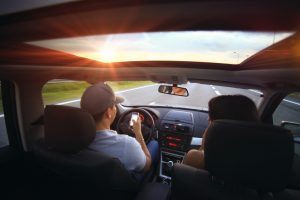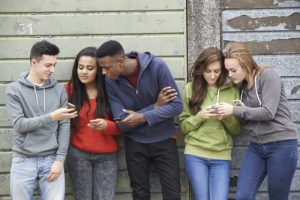22 Distracted Driving
Summer Johnson; Cody Berlin; and Joshua Altmann
Intro
Distracted driving caused more than 2,800 deaths in 2018, and this number only continues to rise. This chapter will explore the psychological problems attached to distracted driving, including things such as texting and driving, the effects that substances may have when used on the road, and the generational differences in attention span. Furthermore, these three topics will briefly dive into how the brain multitasks, our states of consciousness (more specifically, how they affect the way we drive), and lastly lifespan development.
Texting and Driving

The first issue that will be discussed in this chapter is the use of phones while behind the wheel. It’s general knowledge that texting and driving is very dangerous, hence why it’s illegal in forty-eight states. However, is there anything in Psychology that could describe why it is that we can’t text and drive simultaneously? In fact, there is. According to Frances Freidrich from the University of Utah, cognitive distractions cause a lack of awareness of what’s in front of us. There have also been studies using eye-tracking devices that have proven the fact that when we are texting while driving, this slows our reaction time and thus can cause many accidents. Although humans tend to be good multitaskers, our brains are not meant to be actively focused on more than one thing at once, so focusing more on one thing slows down how fast we can react while doing the other.
Substance Use While Driving
The next larg est cause of distracted driving is drug and substance usage. How do these substances affect our driving? The most used drug taken before someone drives is alcohol. Alcohol is considered a depressant, which can cause sleep, motor disturbances, memory loss, and death. Another common drug that can easily impair driving is a hallucinogen like marijuana or LSD. These can cause perceptual changes either mild or intense depending on the type, strain, and method of ingestion. Stimulants such as cocaine, amphetamines, and methamphetamines (also known as meth) cause increased alertness, euphoria, agitation, paranoia, sometimes hallucinations, heightened sensitivity to physical stimulus, and death. Finally, opiates like opium, heroin, fentanyl, morphine, etc. can all cause pain relief, euphoria, sleepiness, and death. These effects are harmful to the user and those around them because they are less aware of their surroundings while driving. Peer pressure and parties are dangerous activities for young adults and specifically teenagers, and it is even more necessary for people to know the effects of these drugs as they grow up so they can learn to avoid them.
est cause of distracted driving is drug and substance usage. How do these substances affect our driving? The most used drug taken before someone drives is alcohol. Alcohol is considered a depressant, which can cause sleep, motor disturbances, memory loss, and death. Another common drug that can easily impair driving is a hallucinogen like marijuana or LSD. These can cause perceptual changes either mild or intense depending on the type, strain, and method of ingestion. Stimulants such as cocaine, amphetamines, and methamphetamines (also known as meth) cause increased alertness, euphoria, agitation, paranoia, sometimes hallucinations, heightened sensitivity to physical stimulus, and death. Finally, opiates like opium, heroin, fentanyl, morphine, etc. can all cause pain relief, euphoria, sleepiness, and death. These effects are harmful to the user and those around them because they are less aware of their surroundings while driving. Peer pressure and parties are dangerous activities for young adults and specifically teenagers, and it is even more necessary for people to know the effects of these drugs as they grow up so they can learn to avoid them.
Generational Differences that Affect Driving
The last major topic discussed in this chapter is how generational differences may actually affect how we drive. When adults drive, they most likely have been driving for a while and don’t have to pay quite as much conscious attention to the road in order to get to their destination unharmed. However, most teenagers don’t have this ability yet and we are also more likely to be driving with friends (which can obviously be distracting) or doing any number of things that could be keeping our attention off the road in front of us. According to Chapter twelve of our PSY 101 textbook, “Social roles are defined by culturally shared knowledge. That is, nearly everyone in a given culture knows what behavior is expected of a person in a given role.” This being said, it can be assumed that a teenager driving with friends would act much differently from a teenager driving with their parent, or even a parent driving with an infant in the backseat. Teenagers are more likely to be talking, changing playlists on their phone, or just overall making bad decisions when trying to entertain their friends in the car. All of these distractions can be incredibly dangerous, especially for teenagers who are less-experienced behind the wheel.
Concluding Thoughts
We think it’s important to leave with some helpful tips to avoid accidents and overall distractions while driving. It’s a good idea to put your phone away and on Do Not Disturb while driving, or if you need it for things such as GPS, keep it out of your reach so that it causes fewer interruptions in your driving. Don’t do drugs, especially before you drive, and if you know that you will be or already are, have a designated driver or take an Uber. Taking simple safety precautions as well as being aware of yourself and your surroundings while driving can dramatically reduce car accidents, and lead to a much happier, safer experience on the road.
Below are some helpful community resources:
- CARE and Conduct Office- The CARE and Conduct Office at PVCC is a great place for students to learn about making ethical choices to help their education. They can help students who are having issues inside and outside the classroom and whether it’s behavioral or lack of resources. Their webpage can be found here.
- SAMHSA National Helpline- Also known as Treatment Referral Routing Service is a confidential, free, 24-hour-a-day, 365-day-a-year, information service, in English and Spanish, for individuals and family members facing mental and/or substance use disorders. This service provides referrals to local treatment facilities, support groups, and community-based organizations. Callers can also order free publications and other information. More information can be found here.
- EndDD- EndDD is dedicated to ending texting and driving and saving lives through advocacy, education, and action. They have given talks and presentations to thousands across the country. Learn more about the dangers of distracted driving from them. Their webpage can be found here.
- Stop and Go Driving School- There are several different courses offered here like defensive driving, traffic survival school, and driver’s education. With their certified instructors anyone can learn driving. More information can be found here.
- Public Safety Office (PVCC)- The public safety office at PVCC gives helpful guidelines and information about how to stay safe on campus and protect yourself from dangerous situations. Their phone number is 602-787-7900.
Media Attributions
- 917003 © pxhere is licensed under a CC0 (Creative Commons Zero) license
- blur car motion ride © tookapic is licensed under a CC0 (Creative Commons Zero) license
- psy 3


